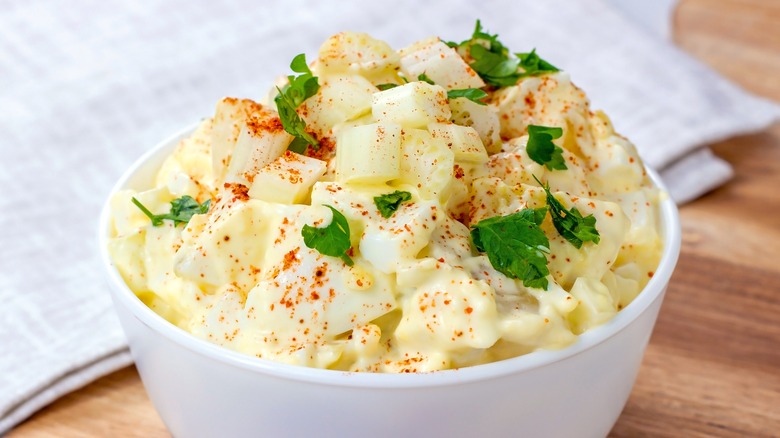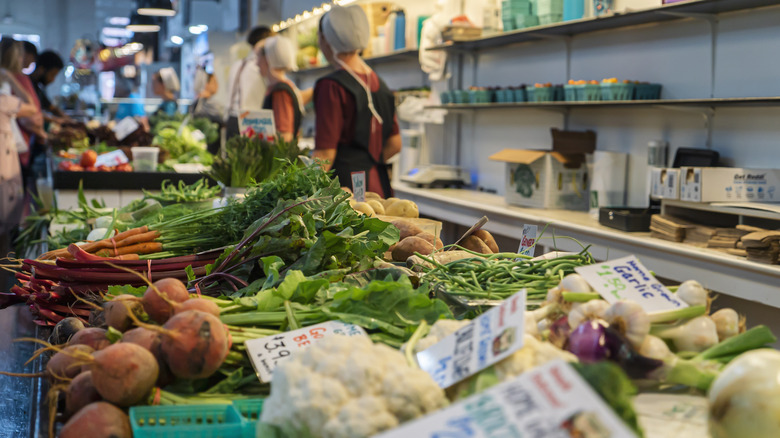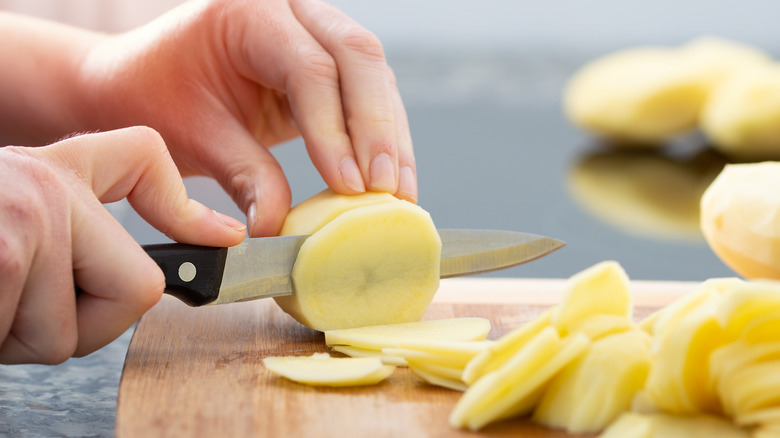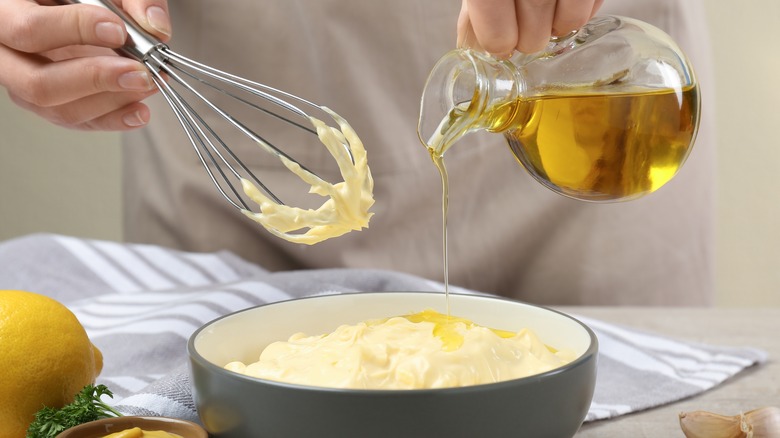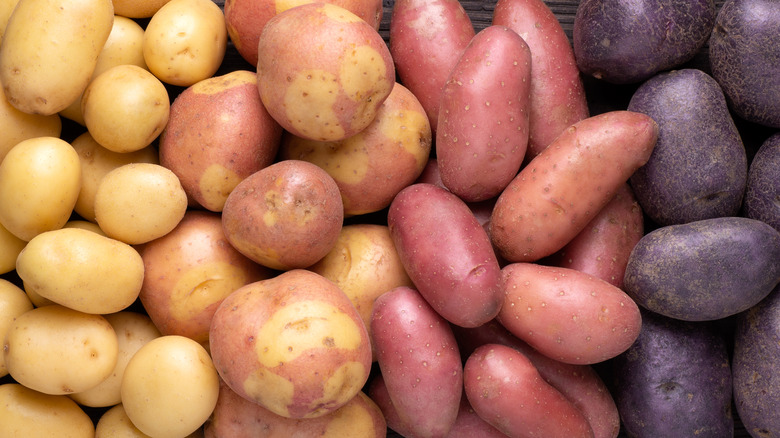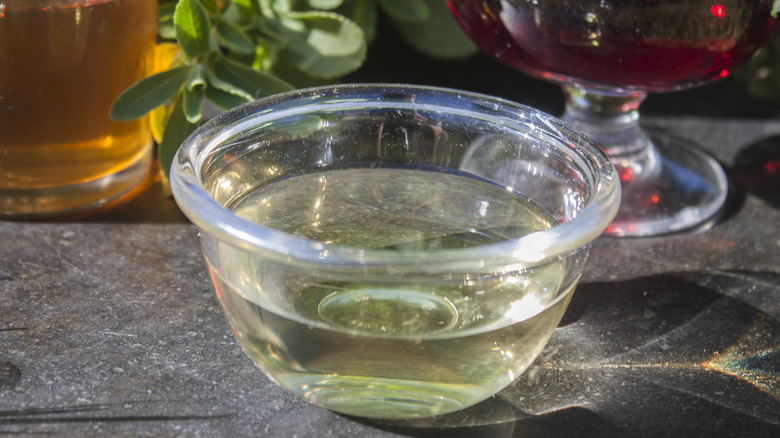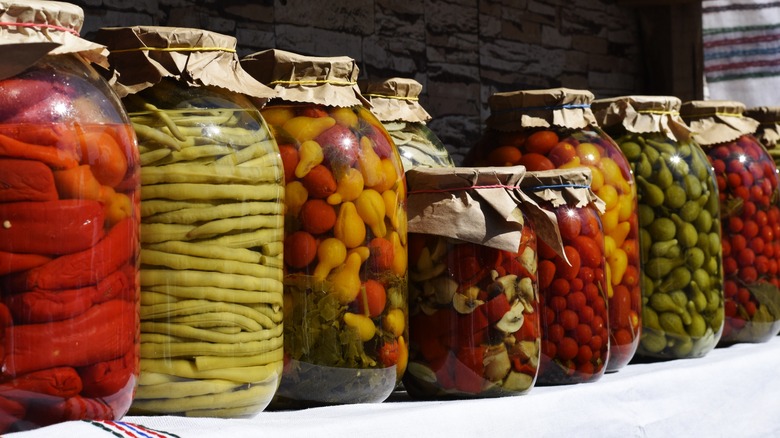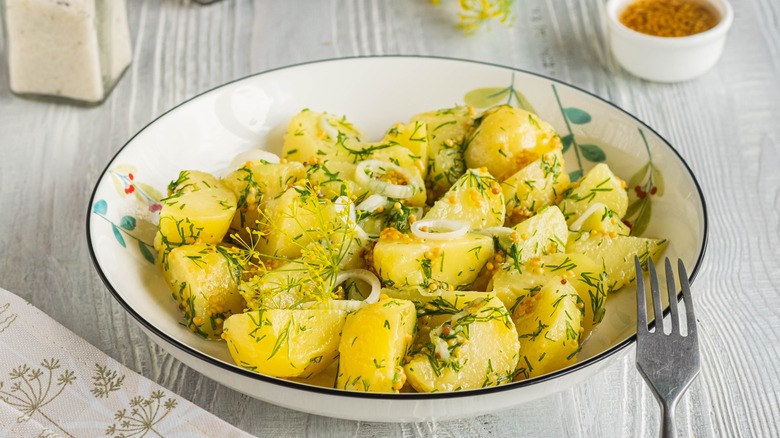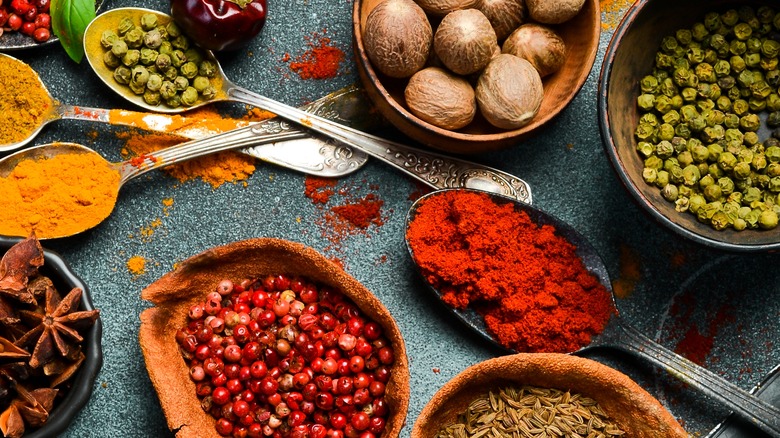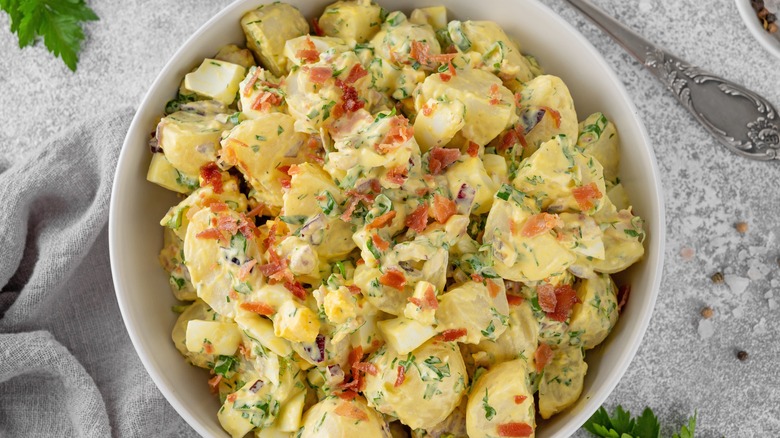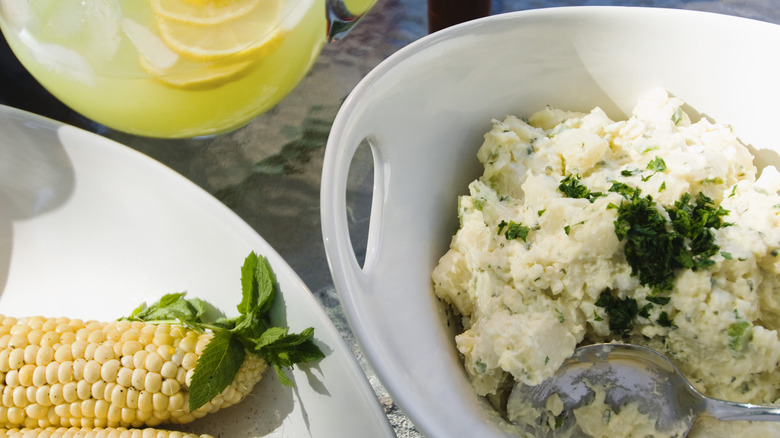What Is Amish Potato Salad And What Makes It So Delicious?
It's creamy and tangy, with a decadent mayonnaise dressing that coats each potato piece. Some bowls are robust and hearty, with the bold flavors of smoked paprika and caramelized onion. Others are packed with the bright, citrusy flavor of lemon, herbaceous dill, or spicy basil. As a side dish, it's equally at home served with burgers and hot dogs on a warm summer day or devoured with a quick grab-and-go sandwich as part of a weekday lunch. You can even commonly find it served during formal and festive holiday meals or an eclectic communal potluck.
Of course, we're talking about the one and only classic comfort food known as potato salad. From rich and smoky, bacon-packed German potato salad to sweet and tart French potato salad (beloved for its use of shallots and Dijon mustard), there are many different types of potato salad to know and love. But when it comes to the most iconic — and perhaps most delicious — of all potato salads, nothing quite compares to classic old-school Amish-style potato salad.
Amish potato salad has a rustic and hearty, robust flavor that celebrates simple, wholesome ingredients. It's both zesty and indulgent, with a lush, velvety texture and delightful balance of savory and sweet flavors. But Amish potato salad's unique blend of ingredients, including staples like mayonnaise, mustard, and sugar, is just the start of what makes this fantastic dish so incredibly delicious.
A brief history of Amish potato salad
People of the Amish faith first arrived in the United States in large numbers in the mid 18th century, driven out of Europe by religious persecution and the desire to find a place of freedom they could call home. Anchored around a core value system of tradition, simplicity, humility, and faith, the Amish thrived in America, and the population grew steadily in many wonderful tight-knit farming communities across the country. Known for their distinctive dress and rejection of electricity and automobiles, many Amish have devoted their lives to marvelous cultural pursuits like woodworking, quilting, soap and candle making, canning and pickling — and of course — baking and cooking.
Amish farm stands are famous for their incredible produce and some of the best-tasting, made-from-scratch foods you can buy anywhere. There are fantastic, dense and crispy-crusted homemade breads, knotty and salty pretzels, clove and cinnamon-infused apple butters, and rich molasses-based shoofly pies. But perhaps the most popular of all Amish foods, and the one people crave and clamor for the most throughout the year, is Amish-style potato salad.
Loved by people of all ages and backgrounds, Amish potato salad's wide appeal makes it a go-to choice for gatherings and potlucks. Whether served alongside grilled meats at a barbecue or as part of a holiday feast, it's a versatile and popular choice for any occasion and the epitome of a true crowd-pleasing dish. A big part of that appeal comes down to the way the salad is made.
A Taste of Tradition
Amish potato salad is timeless and classic, based on recipes passed down through generations. It's comfort food in the truest sense, homey and welcoming, and based on familiar (and exceptionally delicious) flavors. Part of its charm comes from the fact that it's made with simple, wholesome ingredients — farm-fresh veggies and staples you always have on hand in the pantry and fridge (or that you can gather daily, in the case of the Amish cooks who created the dish).
Look at any popular Amish potato salad recipe, and there's almost zero chance you'll find anything that comes premade or that you couldn't grow or make yourself. Instead, you'll see essentials like potatoes, hard-boiled eggs, mayo, mustard, vinegar, sugar, salt, black pepper, a variety of fresh and dried herbs and spices, and different fresh produce.
More than just comforting, the dish is hearty and filling. Amish potato salad is typically prepared in large batches, creating generous portions that you can dole out to feed a crowd. It's relatively simple to make — just boil, peel, and dice your potatoes and then combine all your other ingredients together in a bowl and serve. It's also economical. And, in our fast-paced modern world, it provides a taste of the past— slow living, simple pleasures, and a peek back to a simpler time. Yes, it tastes exceptionally good, but it's also a culinary time machine to the past, and that makes it even more mouth-wateringly delicious.
Amish potato salad's secret ingredient
Mayo is always an essential ingredient in all lush and creamy salads, including potato salad. But one key thing that makes real, traditional Amish-style potato salad so special and unique is that the mayo used in its sauce isn't Hellmann's or Miracle Whip. In fact, it doesn't come from a jar at all. Instead, Amish potato salad is typically made with a rich, luscious blend of oil, egg yolks, vinegar, and spices — ingredients you whisk together yourself to make a classic homemade mayonnaise.
For those who've never tried, making your own mayo is easier than you might think. Start by whisking together egg yolks and a small amount of vinegar or lemon juice in a bowl. Then, gradually add oil, a few drops at a time, while whisking continuously. This will help the mixture to emulsify and thicken. As it does, you can add even more oil, making the mayo thicker and thicker, until it reaches just the right consistency. Once your basic mayonnaise is set, customize it however you want, adding mustard, salt, sugar, or other spices and whisking once again until everything is well combined.
Using homemade mayo in the dish doesn't just strip unnecessary preservatives and stabilizers from Amish potato salad. It also ensures you're using the freshest ingredients possible, with the biggest, boldest, brightest flavor profiles. Homemade mayo is also often richer and creamier tasting, making Amish potato salad — or any salad it's used in — even more extraordinary.
The best potatoes for Amish potato salad
Potatoes don't always get the attention they deserve when it comes to individual varieties and the unique flavors and qualities each can bring to a dish. If you're making potato salad, you might think any potato will do. Yet that's not the case. Part of what makes a great potato salad so tasty — including Amish potato salads — is the choice of the right potato as a key ingredient.
In general, when you're boiling potatoes to make a potato salad, do as the Amish do and pick a good waxy potato with a firm texture and thin skin. Red potatoes, for example, are a perfect choice for Amish potato salad. So, too, are fingerling potatoes and multipurpose Yukon Golds. All of these potatoes have a lower starch content and higher moisture content, which helps them retain their shape and texture better when cooked. As for individual flavors, red potatoes tend to be slightly sweeter and earthier; fingerlings are a bit richer and nuttier, and Yukon Golds are said to be more buttery and creamy overall. But whichever you pick — or whichever somebody else uses when making Amish potato salad — the results will be spectacular!
On the flip side, the secret the Amish know (and that you should know as well) is that starchier potatoes like Russets are not ideal for potato salad. Instead, save these fluffy, low-moisture spuds for mashing, which is where they truly shine.
The importance of acid
Cooks and farmers have been creating vinegar by fermenting various fruits and vegetables for thousands of years — the practice dates back to the days of Babylon in around 5000 B.C., according to some estimates. The Amish were already adept at making vinegar well before they ever immigrated to the United States, and they brought that skill with them to their new home.
Vinegar has countless uses in Amish cooking. It's a key component of salad dressings and marinades. It's vital in the production of pickles and relish. It's also sometimes used in bread making and baking. And, vinegar plays an essential role in helping to make Amish potato salad so incredibly delicious and refreshing.
Along with mayo and mustard, vinegar (usually apple cider or even regular white) is part of the trifecta of ingredients that make up the tart, tangy, creamy sauce that Amish potato salad is so known for. It also plays a number of essential roles in the dish. Vinegar adds a bright, sour, acidic flavor to potato salad, balancing the richness of the mayonnaise and adding depth and complexity to the salad. But it also acts as a natural preservative, helping to extend the shelf life of potato salad and prevent the growth of harmful bacteria. Finally, and perhaps most importantly, vinegar helps to tenderize the potatoes slightly, giving them a softer texture and ensuring they absorb the flavors of the dressing more effectively.
All about pickles and relish
From making jams and jellies to canned tomatoes, salsas, and chutneys, the Amish are world-renowned for their mastery of home canning and preserving. Homemade pickles and relish are also high on that list of Amish specialties, so it makes sense that these delicious treats would be included as essential ingredients in Amish potato salad. Whether it's sweet gherkins made from baby cucumbers, large cukes that are turned into tasty dill pickles, or a sweet and tangy relish made from diced cucumber or even zucchini, relish and pickles add a distinctive burst of flavor to Amish potato salad that you can't get with anything else.
Pickles and relish provide sweetness, zestiness, and spice to Amish potato salads, along with a touch of wonderful tartness, texture, and crunch. They make the salad prettier as well, imbuing it with pops of green and even red, depending on the type of pickled ingredient that's used.
Pickles and relish also give Amish cooks a chance to break out of the mold and create a favorite personalized dish. While essentials like potatoes, eggs, sugar, mayo, and mustard are included in almost all Amish potato salads, the type of pickle or relish that's used can vary greatly. Some families prefer sweet bread and butter-style pickles in their salads. Others opt for dill. But you could also use spicy pickled peppers, pickled red onions, pickled green beans, and even pickled beets to give your Amish-style potato salad a unique and distinctive twist.
Creating the perfect tang
Like homemade mayonnaise, mustard is another readily available condiment on many Amish farms. Mustard plants are tall, fragrant, and beautiful herbs that grow readily in fields across the United States. These fantastic plants produce thousands of tiny round seeds that can be ground and mixed with vinegar to make that spicy yellow sauce we are all so familiar with.
However, the Amish cooks who created the earliest potato salad recipes didn't just fill them with mustard because the farms had a lot of the stuff on hand. They likely made mustard an integral part of Amish potato salad because of the fantastic tartness, tang, and spice the herb brings to the dish. There are lots of different kinds of mustard to try. Amish potato salad typically includes yellow mustard as its key ingredient.
But even though yellow mustard is affordable, popular, and widely available, this is also one place where you can easily bring your own unique twist to any Amish potato salad you make at home. Swap in some Dijon mustard for hints of added tartness and spice. Whole grain mustard will give your potato salad a nuttier, earthier taste, plus some wonderful added texture and crunch. (Because it's so rustic, it's also likely closer to what the first Amish cooks may have used in their original potato salad recipes.) You could also use honey mustard for sweetness, or horseradish or spicy brown mustard for a potato salad with a kick!
An ideal blend of classic spices
Sumac, curry powder, grains of paradise, and nigella seeds are just some of the many unusual and underutilized spices you can add to a dish to really elevate it and make it special. But you won't find any of these trendy spices in Amish potato salad. Instead, like a great comfort food should be, this dish is all about classic, time-tested, history-approved spices that everybody loves and that always make a dish more delicious.
The bulk of the spice flavor in Amish potato salad is built around simple salt and pepper. Sure, they're fundamentals of good cooking, but they earned that reputation for a reason. Salt helps to balance out the sweetness of the white sugar, which is often blended with mayo to form the foundation of Amish potato salad's sauce. It adds depth and complexity while highlighting the savory notes of the potatoes, eggs, and dressing. Similarly, black pepper adds a subtle heat and spiciness to Amish potato salad, complementing the creamy texture and rich flavor of the mayonnaise and potatoes.
From there, Amish potato salad also often includes paprika, which contributes a mild, earthy flavor, vibrant red color, and hints of sweetness and smokiness to the side. Some cooks add celery seed to their Amish potato salad as well, bringing hints of bitterness and earthiness to each bite. And, for a burst of onion flavor that's less overpowering than raw onion, you can't go wrong with a dash of onion powder.
Eggs: yay or nay?
Should you put eggs in potato salad? This seemingly simple question is a source of ongoing discussion for many chefs and home cooks. For fans of perfectly boiled eggs — free of the many mistakes that can plague hard-boiling — the ingredient is a way to add extra creaminess and richness to an already decadent potato salad. On the other hand, those who are against eggs in their potato salad say eggs ruin the dish, overpowering its flavor and texture and detracting attention away from what should be its true star: the light and delicate potato!
For Amish-style potato salad, however, there is no debate. Eggs are almost always a central and essential part of the dish. It makes sense. On Amish farms, eggs are plentiful and used in countless ways, not just because they're tasty but also because of their availability and the nutrition they bring. In potato salad in particular, eggs help to make the side more substantial and satisfying. Yes, they provide richness, but they also provide protein and a savory heft to the salad that you don't get from potatoes alone.
To prevent eggs from overpowering any homemade Amish potato salad you make yourself, always use them in moderation — one for every two to three potatoes in your salad, max. Also, try to cut the eggs into fine pieces before mixing them in. This ensures you won't get any bites with big egg chunks that will provide a more dominant "eggy" flavor.
The best Amish potato salad mix-ins
One of the best things about any potato salad — including Amish-style salads — is that it's so versatile and can be customized in so many different ways. Most (but not all) Amish potato salads include at least a small amount of sugar, which is part of what gives them their distinctive sweetness. Sugar also complements the zest and tang of mustard, pickles, and spices to give Amish potato salad its unique one-of-a-kind flavor.
But Amish cooks don't always stop with adding sugar to their potato salad. Many mix in other ingredients as well, most of which are grown right on the farm and added or subtracted to the dish based on the season and their overall availability. In the spring, salads might get a handful of tender asparagus, thinly sliced radishes, or chopped green onions as a special addition. As the growing season moves into summer, those ingredients are often replaced with whole cherry tomatoes or diced fresh cucumber or bell pepper. And in the fall and winter, it's not uncommon to find Amish-style potato salads that feature diced apples, slices of crisp celery, or even shredded Brussels sprouts.
In addition to seasonal produce, chopped fresh herbs (such as parsley, dill, chives, or cilantro) are sometimes added to Amish-style potato salad. And, just as in many other cultures — and styles of potato salad — it's not unheard of for an Amish cook to add some crumbled bacon or grated or diced cheese to their potato salad.
Serving and storing your Amish potato salad
Finally, when it comes to serving and storing any perfectly prepared Amish potato salad, there's one way we can elevate the dish and make it even more flavorful than it already is. That's by chilling our salad before we dig in. From chicken or pasta salads to Amish potato salad, mayo-based dishes always taste better when they're cold. That extra resting time after the salad has been prepared also gives all the flavors of the ingredients in the salad time to gel and meld and for all their unique qualities to become more pronounced and truly shine.
Some Amish families like to serve their potato salad immediately after it has been made, right along with all the other freshly prepared dishes in a meal. Others will sometimes let their potato salad chill for a bit in a root cellar, or serve it sitting in another bowl that's filled with ice to help keep it cool.
But you can do one better and make it a habit to always store your Amish potato salad in the fridge for at least an hour or two before serving. This will not only help to preserve the freshness of all those wonderful farm-fresh ingredients but also heighten their already bold and vibrant flavors. In other words, that already tasty Amish potato salad will be even more satisfying and delicious!

